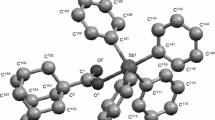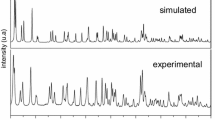Abstract
Thermodynamic investigation using the relaxation calorimetry technique and the microchip calorimetry technique is performed to clarify low-temperature behaviors of a radical cation salt consisting of a donor molecule of bispropylenedithiotetrathiafulvalene (BPDT-TTF) and a linear anion of \({{\text{ICl}}_{2}^{-}}\). This compound has a layered structure similar to numerous BEDT-TTF compounds. The donor molecules form a dimerized arrangement in the layer. Temperature dependence of heat capacity obtained by the relaxation technique shows a broad hump structure around 20–25 K corresponding to the temperature where the magnetic susceptibility shows a drastic decrease due to the formation of the singlet spin state. The microchip calorimetry technique detected a step-like anomaly around 23 K in the temperature dependence of C p T −1 of which entropy is evaluated as only few % of Rln2 corresponding to the full entropy of localized π-electrons located on each dimer unit. The negligibly small T-linear term in the low-temperature heat capacity and absence of magnetic fields dependence below 3.2 K predict opening of rigid gap structure in the spin excitations, which is consistent with a spin-singlet formation due to the formation of spin-Peierls type ordering or charge ordering state.





Similar content being viewed by others
References
Ishiguro T, Yamaji K, Saito G. Organic superconductors. 2nd ed. Heidelberg: Springer-Verlag; 1998.
Williams JM, Ferraro JR, Thorn RJ, Carlson KD, Geiser U, Wang H-H, Kini AM, Whangbo M-H. Organic superconductors. Englewood Cliffs: Prentice-Hall; 1992.
Bernier P, Lefrant S, Bidan G, editors. Advances in synthetic metals. Lausanne: Elsevier; 1999. p. 262–348.
Kanoda K. Metal-insulator transition in κ-(ET)2X and (DCNQI)2M: two contrasting manifestation of electron correlation. J Phys Soc Jpn. 2006;75:051007:1–16.
Kato R. Conductive copper salts of 2,5-disubstituted N,N’-dicyanobenzoquinonediimines (DCNQIs): structure and properties. Bull Chem Soc Jpn. 2000;73:515–34.
Nigrey PJ, Eugene BM, Venturini L, Azevedo LJ, Schirber JE, Perschke SE, Williams JM. Synthesis, structure, and properties of (BPDT-TTF)2IBr2. Phys B. 1986;143:290–2.
Kobayashi H, Takahashi N, Kato R, Kobayashi A, Sasaki Y. The crystal structure and electrical resistivity of (BPDT-TTF)2I3. Chem Lett. 1984;8:1331–4.
Sorai M, editor. Comprehensive handbook of calorimetry and thermal analysis. Chichester: Wiley; 2004.
Nakazawa Y, Kawamoto A, Kanoda K. Characterization of low-temperature electronic states of the organic conductors α-(BEDT-TTF)2MHg(SCN)4 (M = K, Rb and NH4) by specific-heat measurements. Phys Rev B. 1995;52:12890–4.
Muraoka Y, Yamashita S, Yamamoto T, Nakazawa Y. Microchip-calorimetry of organic charge transfer complex which shows superconductivity at low temperatures. Thermochim Acta. 2012;532:88–91.
Muraoaka Y, Yamashita S, Yamamoto T, Nakazawa Y. AC heat capacities of κ-(BEDT-TTF)2Cu2(CN)3 measured by microchip calorimeter. J Phys Conf Ser. 2011;320:012027:1–6.
Fukuoka S, Yamashita S, Yamamoto T, Nakazawa Y, Kobayashi A, Kobayashi H. Magnetic heat capacities of κ-(BETS)2FeBr4 measured by a microchip calorimeter. Phys Status Solid. 2012;C9:1174–6.
Bonner JC, Fisher ME. Linear magnetic chains with anisotropic coupling. Phys Rev. 1964;135:A640–58.
Nakazawa Y, Sato A, Seki M, Saito K, Hiraki K, Takahashi T, Kanoda K, Sorai M. Spin-Peierls transition of the quasi-one-dimensional electronic system (DMe-DCNQI)2M (M = Li,Ag) probed by heat capacity. Phys Rev B. 2003;68:085112:1–8.
Okuma K, Fujisaki T, Nakazawa Y, Saito K, Oguni M. Unusual low-temperature thermodynamic properties of pellet samples of (DMe-DCNQI)2M (M = Li, Ag). J Therm Anal Calorim. 2005;81:587–90.
Sorai M, Nakazawa Y, Nakano M, Miyazaki Y. Calorimetric investigation of phase transitions occurring in molecule-based magnets. Chem Rev. 2013;113:PR41–122.
de Jongh LJ, Miedema AR. Experiments on simple magnetic model systems. Adv Phys. 2001;50:947–1170.
Yamashita S, Nakazawa Y. Heat capacities of antiferromagnetic dimer-Mott insulators in organic charge-transfer complexes. J Therm Anal Calorim. 2010;99:153–7.
Nakazawa Y, Yamashita S. Thermodynamic properties of κ-(BEDT-TFF)2X salts: electron correlations and superconductivity. Crystals. 2012;2:741–61.
de Souza M, Brühl A, Müller J, Foury-Leylekian P, Moradpour A, Pouget J-P, Lang M. Thermodynamic studies at the charge-ordering and spin-Peierls transitions in (TMTTF)2X. Phys B. 2009;404:494–8.
Acknowledgments
This work was supported in part by Grant-in-Aid for Scientific Research (Nos. 23110717 and 22340098) from the MEXT and JSPS.
Author information
Authors and Affiliations
Corresponding author
Rights and permissions
About this article
Cite this article
Guan, G., Fukuoka, S., Yamashita, S. et al. Magnetic transition in dimerized radical cation salt of (BPDT-TTF)2ICl2 studied by heat capacity measurements. J Therm Anal Calorim 113, 1197–1201 (2013). https://doi.org/10.1007/s10973-013-3015-5
Received:
Accepted:
Published:
Issue Date:
DOI: https://doi.org/10.1007/s10973-013-3015-5




